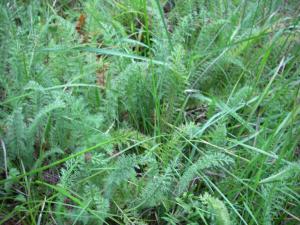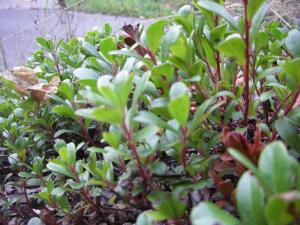Prairie Plants that Existed at the LHG before Fall 2006
Yarrow:
Achillea millefolium
 llea millefolium; from our site: llea millefolium; from our site:
(Pic by LD from LHG Oct. 2006)
|
|
millefolium: "thousand leaved": This plant is the first plant medicinal plant known to be written about, used for divination as early as 4200 years ago in ancient China. These inconspicuous feathery plants have diaphoretic and hemostatic properties: causing a sweat, and stopping blood.
Dry(er) sunny areas, with well drained soil. Found alongside roads, in disturbed areas, in grassy rural areas, prairies, alpine areas, rocky ledges, and near the sea shore. Genetically complex and one to many species recognized.
|
|
|
Kinnickinnick:
Arctostaphylos uva-ursi

Kinnikinnik from our site.
(Pic by LD from LHG Oct 2006)
|
|
kinnickinnik:
kinnikinnik
smooth scleryphylous evergreen
northwest heather
sacred smoke
loves sunny slopes
colonizing entertwining
rootedness
spirally reaching for the
sun
Kinnickinnik likes the most open rocky exposed areas it can get in the Pacific Northwest. On the East side of the Cascades, however, Snowberrry favors the moister areas. Survival is a game of running from lacks to larders. Kinnickinnik is a sacred plant used in smoking mixtures with tobacco and other herbs.
|
|
Blue Camas:
Cammasia Quamash
 Emergent Camas in our Garden Site Emergent Camas in our Garden Site
(Pic by JC from LHG 16.Mar.2007)
|
|
Braken fern:
Pterium aquilinum
 Bracken Fern Bracken Fern
|
Braken fern is pretty much the most cosmopolitan plant on the planet, growing on 6 continents and many different ecosystems. When Mt. St. Helens erupted, Bracken fern was on of the first plants to return. Bracken fern pollen is often one of the first found in the pollen record after natural disasters. With that said, it grows in wet ditches to dry sites, low elevations to high. Bracken fern roots were an important staple in many Pacific NW first peoples communities. Its long starch roots made it especially valuable, and yet one more reason to inhibit ecological succession by utilizing intentional fires. |
Trailing Blackberry:
Rubus ursinus
 Trailing Blackberry : (Pic by LD from LHG Oct 2006) Trailing Blackberry : (Pic by LD from LHG Oct 2006)
|
This plant is growing all over the site, and incidentally, trailing blackberry doesn't really flower and fruit in the forest, but creeps and extends itself vegetatively. It waits for trees to fall down, or a fire. Then it "trails" into the area from the edges and reproduces like mad. |
|